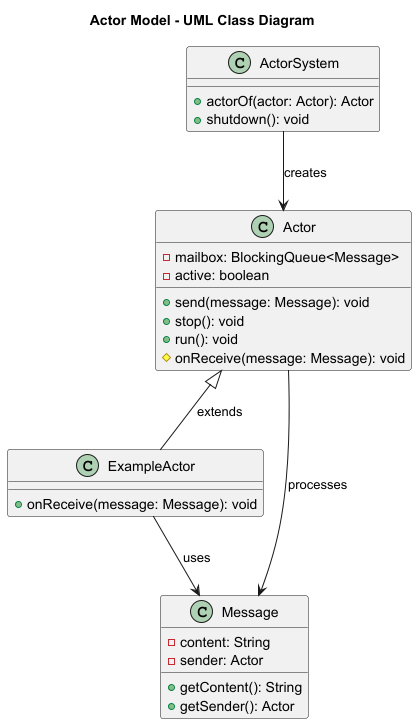Actor Model Pattern in Java: Building Concurrent Systems with Elegance
About 2 min
Also Known As
- Message-passing concurrency
- Actor-based concurrency
Intent of Actor Model Pattern
The Actor Model pattern enables the construction of highly concurrent, distributed, and fault-tolerant systems by using isolated components (actors) that interact exclusively through asynchronous message passing.
Detailed Explanation of Actor Model Pattern with Real-World Examples
📦 Real-world Example
Imagine a customer service system:
- Each customer support agent is an actor.
- Customers send questions (messages) to agents.
- Each agent handles one request at a time and can respond asynchronously without interfering with other agents.
🧠 In Plain Words
"Actors are like independent workers that never share memory and only communicate through messages."
📖 Wikipedia Says
Actor model is a mathematical model of concurrent computation that treats "actors" as the universal primitives of concurrent computation.
🧹 Architecture Diagram

Programmatic Example of Actor Model Pattern in Java
Actor.java
public abstract class Actor implements Runnable {
@Setter @Getter private String actorId;
private final BlockingQueue<Message> mailbox = new LinkedBlockingQueue<>();
private volatile boolean active = true;
public void send(Message message) {
mailbox.add(message);
}
public void stop() {
active = false;
}
@Override
public void run() {
}
protected abstract void onReceive(Message message);
}Message.java
@AllArgsConstructor
@Getter
@Setter
public class Message {
private final String content;
private final String senderId;
}ActorSystem.java
public class ActorSystem {
public void startActor(Actor actor) {
String actorId = "actor-" + idCounter.incrementAndGet(); // Generate a new and unique ID
actor.setActorId(actorId); // assign the actor it's ID
actorRegister.put(actorId, actor); // Register and save the actor with it's ID
executor.submit(actor); // Run the actor in a thread
}
public Actor getActorById(String actorId) {
return actorRegister.get(actorId); // Find by Id
}
public void shutdown() {
executor.shutdownNow(); // Stop all threads
}
}App.java
public class App {
public static void main(String[] args) {
ActorSystem system = new ActorSystem();
Actor srijan = new ExampleActor(system);
Actor ansh = new ExampleActor2(system);
system.startActor(srijan);
system.startActor(ansh);
ansh.send(new Message("Hello ansh", srijan.getActorId()));
srijan.send(new Message("Hello srijan!", ansh.getActorId()));
Thread.sleep(1000); // Give time for messages to process
srijan.stop(); // Stop the actor gracefully
ansh.stop();
system.shutdown(); // Stop the actor system
}
}When to Use the Actor Model Pattern in Java
- When building concurrent or distributed systems
- When you want no shared mutable state
- When you need asynchronous, message-driven communication
- When components should be isolated and loosely coupled
Actor Model Pattern Java Tutorials
Real-World Applications of Actor Model Pattern in Java
- Akka Framework
- Erlang and Elixir concurrency
- Microsoft Orleans
- JVM-based game engines and simulators
Benefits and Trade-offs of Actor Model Pattern
✅ Benefits
- High concurrency support
- Easy scaling across threads or machines
- Fault isolation and recovery
- Message ordering within actors
⚠️ Trade-offs
- Harder to debug due to asynchronous behavior
- Slight performance overhead due to message queues
- More complex to design than simple method calls
Related Java Design Patterns
References and Credits
- Programming Erlang, Joe Armstrong
- Reactive Design Patterns, Roland Kuhn
- The Actor Model in 10 Minutes, InfoQ Article
- Akka Documentation